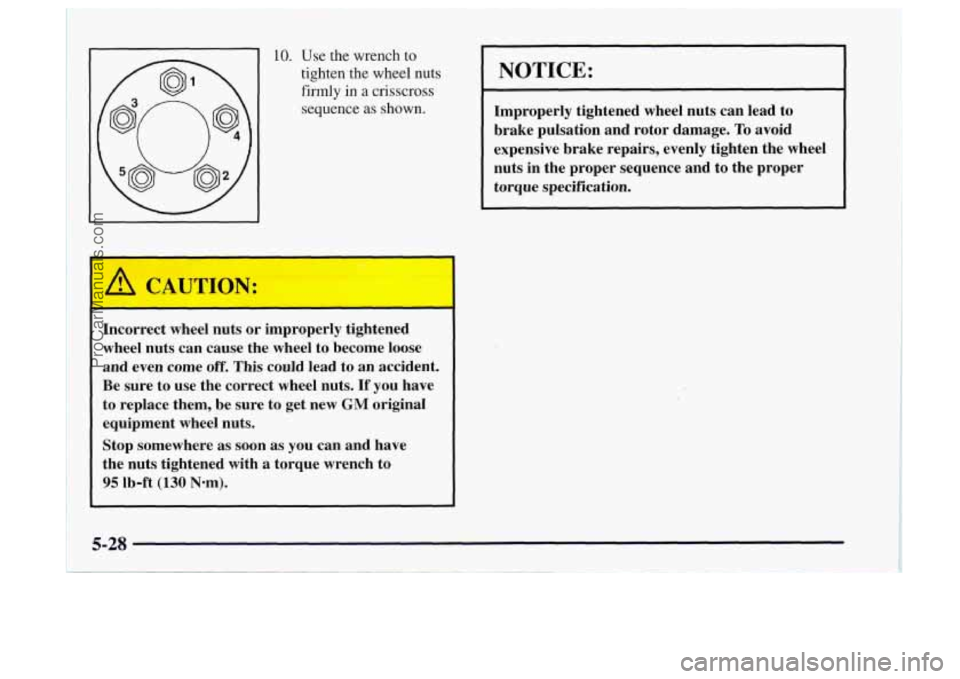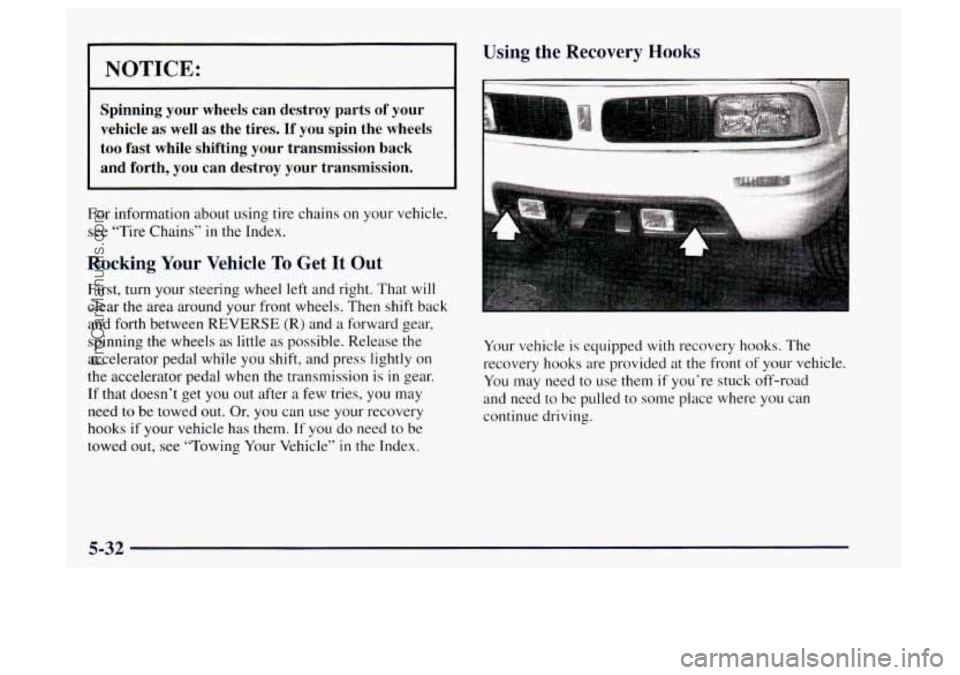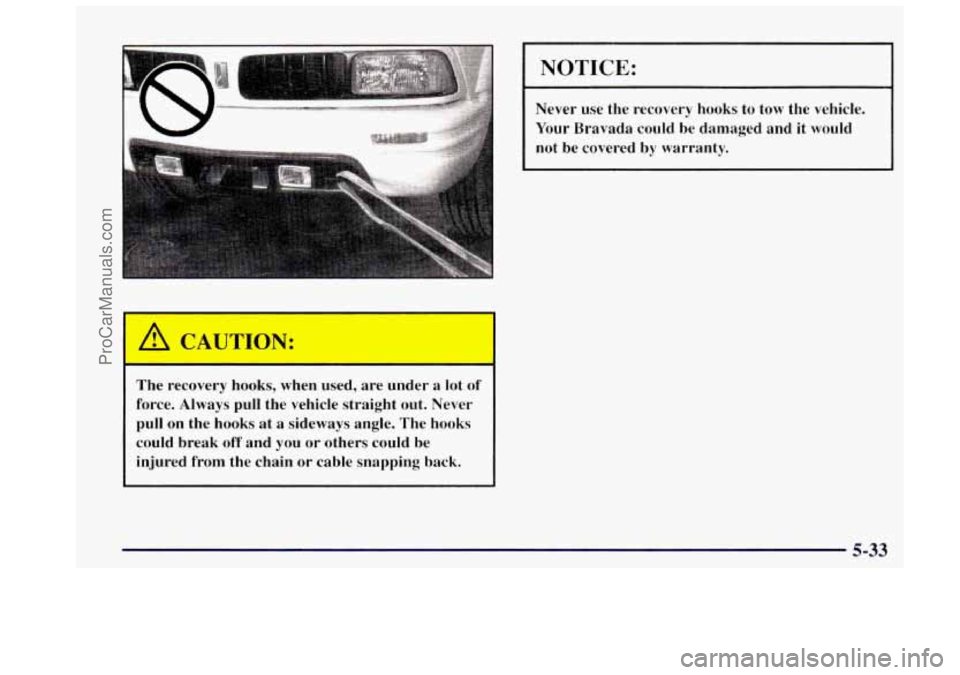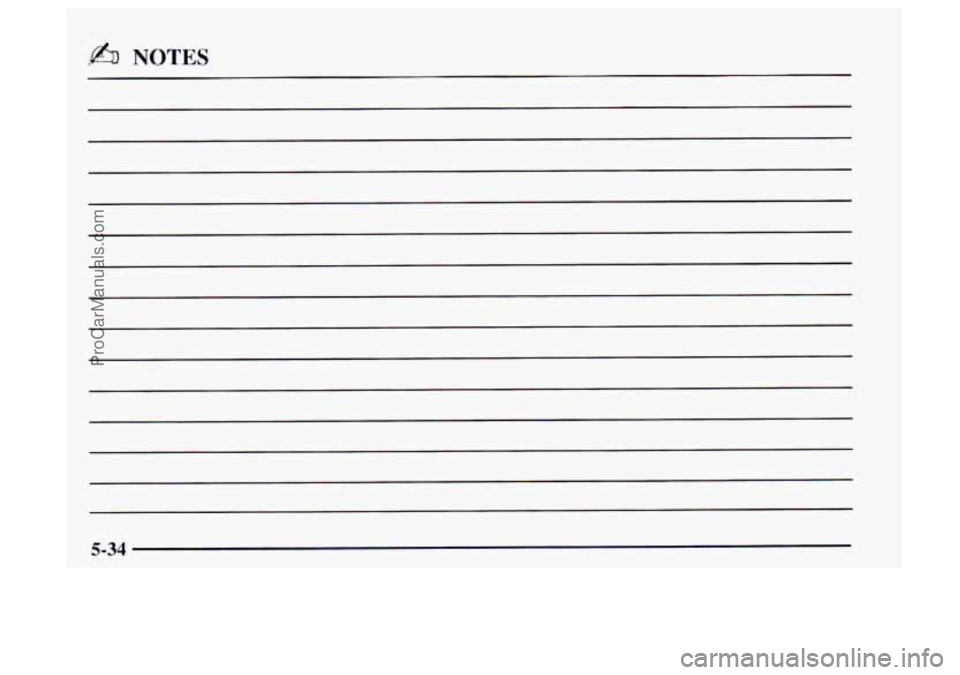OLDSMOBILE BRAVADA 1997 Owners Manual
Manufacturer: OLDSMOBILE, Model Year: 1997, Model line: BRAVADA, Model: OLDSMOBILE BRAVADA 1997Pages: 358, PDF Size: 18.02 MB
Page 211 of 358

A. Front Frame Hole
B. Spring Hanger Hole
,A CAUTICY:
Getting under a vehicle when it is jacked up is
dangerous.
If the vehicle slips off the jack, you
could be badly injured or killed., Never get under
a vehicle when it is supported only by a jack.
NOTICE:
Raising your vehicle with the jack improperly
positioned will damage the vehicle or may allow
the vehicle to fall off the jack. Be sure to fit the
jack lift head into the proper location before
raising your vehicle.
ProCarManuals.com
Page 212 of 358

4. Raise the vehicle by turning the jack handle clockwise.
Raise the vehicle
far enough off the ground so there is
enough
room for the spare tire to fit.
5. Remove all the wheel nuts and take off the flat tire.
6. Remove any rust or dirt
from the wheel bolts,
mounting surfaces and
spare wheel.
'
A CAUT 3%
I
Rust or dirt on the wheel, or on the parts to
which it is fastened, can make the wheel nuts
become loose after a time. The wheel could come
off and cause an accident. When
you change a
wheel, remove any rust or dirt from the places
where the wheel attaches to the vehicle.
In an
emergency, you can use a cloth or a paper towe
to do this; but be sure to use a scraper or wire
brush later,
if you need to, to get all the rust or
dirt
off.
!I
5-26
ProCarManuals.com
Page 213 of 358

A CAUTION:
I - -
Never use oil or grease on studs or nuts. If YOU
do, the nuts might come loose. Your wheel could
fall off, causing
a serious accident.
1
7. Place the spare on the wheel mounting surface.
8. Put the nuts on by
hand. Make sure the
cone-shaped end
is
toward the wheel.
Tighten each
nut by hand
until the wheel
is held
against the hub.
If a nut
can’t be turned by hand,
use the wheel wrench
and see your retailer
as
soon as possible.
I
9. Lower the vehicle by turning the jack handle
counterclockwise. Lower the jack completely.
5-27
-
ProCarManuals.com
Page 214 of 358

1 10. Use the wrench to
~ firmly in a crisscross
tighten the wheel nuts
sequence
as shown.
, Incorrect wheel nuts or improperly tightened
wheel nuts can cause the wheel to become loose
and even come off. This could lead to an accident.
, Be sure to use the correct wheel nuts. If you have
to replace them, be sure to get new
GM original
~ equipment wheel nuts.
Stop somewhere as soon
as you can and have
the nuts tightened with
a torque wrench to
95 lb-ft (130 N-m).
I NOTICE:
Improperly tightened wheel nuts can lead to
brake pulsation and rotor damage.
To avoid
expensive brake repairs, evenly tighten the wheel
nuts in the proper sequence and to the proper
torque specification.
ProCarManuals.com
Page 215 of 358

Storing a Flat or Spare Tire and Tools
' CAT' I ION:
Storing a jack, a tire or other equipment in the
passenger compartment of the vehicle could
cause in.jury. In a sudden stop
or collision, loose
equipment could strike someone. Store
all these
in the proper place.
An aluminum wheel with a flat tire should always
be stored under the vehicle with the hoist.
However, storing it that way for an extended
period could damage the wheel.
To avoid this,
have the wheel repaired as soon as possible. Follow this diagram
to store the spare or flat tire.
BJ
A. Retainer
B. Valve
Stem
(Pointed Down)
C. Spare Tire
D. Spring
E. Wheel Wrench
F. Lower
G. Raise
H. Hoist
Arm
1. Put the tire on the ground at the rear of the vehicle.
with the valve stem pointed down and to the rear.
2. P~dl the retainer through the wheel.
3. Put the chisel end of the wheel wrench. on an angle,
through the hole
in the rear bumper and into the hoist
shaft. Turn the wheel wrench clockwise
until the tire
is raised against the underside of the vehicle.
You will hear two "clicks" when the tire is secure,
but pull on the tire to make sure.
Return
the jack. wheel wrench and wheel blocks to the
proper location
in your vehicle's rear area. Secure the
items and replace the
jack cove]:
5-29
- _-
ProCarManuals.com
Page 216 of 358

h CAUTION:
--
Make sure the tire and carrier are secure.
Driving with the tire or carrier unlatched could
injure pedestrians or damage the vehicle.
rA
A. Retainer
B. Rubber Band
(Some Models)
C. Work Gloves
D. Mat
E. Jack Storage Cover
E Wheel Blocks
G. Hub Cap
Removal Tool
H. Wheel Wrench
I. Jack
J. Jacking Instructions
Compact Spare Tire (If Equipped)
Alt.hough the compact spare tire was fully inflated
when your vehicle was new, it can lose air after
a
time. Check the inflation pressure regularly. It should
be
60 psi (420 kPa).
After installing the compact spare on your vehicle,
you should stop as soon as possible and make sure
your spare tire
is correctly inflated. The compact
spare is made to perform well at speeds up to
65 mph
(105 km/h) for distances up to 3,000 miles (5 000 km),
so you can finish your trip and have your full-size tire
repaired or replaced where you want. Of course, it’s best
to replace your spare with a full-size tire as soon as you
can. Your spare will last longer and be
in good shape in
case you need it again.
5-30
ProCarManuals.com
Page 217 of 358

NOTICE:
When the compact spare is installed, don’t take
your vehicle through an automatic
car wash with
guide rails. The compact spare can get caught on
the rails. That can damage the tire and wheel,
and maybe other parts
of your vehicle.
Don’t use your compact spare on other vehicles.
And don’t
mix your compact spare tire or wheel with
other wheels or tires. They won’t fit. Keep your spare
tire and its wheel together.
NOTICE:
Tire chains won’t fit your compact spare. Using
them can damage your vehicle and can damage
the chains too. Don’t use tire chains on your
compact spare.
If You’re Stuck: In Sand, Mud,
Ice or Snow
What YOU don’t want to do when your vehicle is stuc
to spin your wheels too fast. The method known
as
:k is
“rocking” can help you get out when you’re stuck, but
you must use caution.
If you let your tires spin at high speed, they can
explode, and
you or others could be injured.
And, the transmission or other parts
of the
vehicle can overheat. That could cause an engine
compartment fire or other damage. When you’re
stuck, spin the wheels as little as possible. Don’t
spin the wheels above
35 mph (55 km/h) as shown
on the speedometer.
I
5-31
ProCarManuals.com
Page 218 of 358

NOTICE:
Spinning your wheels can destroy parts of your
vehicle as well as the tires. If you spin the wheels
too fast while shifting your transmission back
and forth, you can destroy your transmission.
For information about using tire chains on your vehicle,
see "Tire Chains''
in the Index.
Rocking Your Vehicle To Get It Out
First, turn your steering wheel left and right. That will
clear the area around your front wheels. Then shift back
and forth between REVERSE
(R) and a forward gear,
spinning the wheels as little as possible. Release the
accelerator pedal while you shift, and press lightly on
the accelerator pedal when the transmission is
in gear.
If that doesn't get you out after a few tries, you may
need to
be towed out. Or, you can use your recovery
hooks
if your vehicle has them. If you do need to be
towed out,
see "Towing Your Vehicle" in the Index.
Using the Recovery Hooks
Your vehicle is equipped with recovery hooks. The
recovery hooks are provided at the front
of your vehicle.
You may need to use them
if you're stuck off-road
and need to be pulled to some place where you can
continue driving.
ProCarManuals.com
Page 219 of 358

I A CAUTION:
-
The recovery hooks, when used, are under a lot of
force. Always pull the vehicle straight out. Never
pull on the hooks at a sideways angle. The hooks could break
off and you or others could be
injured from the chain or cable snapping back.
NOTICE:
-
Never use the recovery hooks to tow the vehicle.
Your Bravada could be damaged and it would
not
be covered by warranty.
5-33
ProCarManuals.com
Page 220 of 358

5-34 .-
ProCarManuals.com